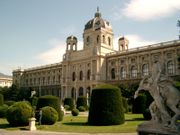
Maria-Theresien-Platz
Encyclopedia

Vienna
Vienna is the capital and largest city of the Republic of Austria and one of the nine states of Austria. Vienna is Austria's primary city, with a population of about 1.723 million , and is by far the largest city in Austria, as well as its cultural, economic, and political centre...
is a large square (Platz) joining the Ringstraße
Ringstraße
The Ringstraße is a circular road surrounding the Innere Stadt district of Vienna, Austria and is one of its main sights...
(Vienna's giant, round, central street) with the Museumsquartier
Museumsquartier
The Museumsquartier is a 60,000 m² large area in the 7th district of the city of Vienna, Austria; it is the eighth largest cultural area in the world. The Museumsquartier contains Baroque buildings as well as Modern architecture by the architects Laurids and Manfred Ortner . The renovation of the...
, a museum of modern arts located in the former Imperial Stables. Facing each other from the sides of the square are two identical buildings, the Naturhistorisches Museum
Naturhistorisches Museum
The Naturhistorisches Museum Wien or NHMW is a large museum located in Vienna, Austria.The collections displayed cover , and the museum has a website providing an overview as a video virtual tour....
- Natural History Museum, and the Kunsthistorisches Museum
Kunsthistorisches Museum
The Kunsthistorisches Museum is an art museum in Vienna, Austria. Housed in its festive palatial building on Ringstraße, it is crowned with an octagonal dome...
- the Art History Museum. These two buildings are identical, save for the statuary on their façades. The Naturhistorisches' façade has statues depicting personifications of the various continents known to Austrian science at the time - Africa, Asia, Europe and the Americas, while the Kunsthistorisches façade features famous European artists - such as the Dutch Bruegel, among others.
The Natural History and Art History museums and the square adjoining them were built in 1891, and in the center of the square is a large statue depicting Empress Marie-Theresa of Austria-Hungary
Austria-Hungary
Austria-Hungary , more formally known as the Kingdoms and Lands Represented in the Imperial Council and the Lands of the Holy Hungarian Crown of Saint Stephen, was a constitutional monarchic union between the crowns of the Austrian Empire and the Kingdom of Hungary in...
, namesake of the square. The Modern Art Museum in the former Imperial Stables shows contemporary works that some may consider controversial. The three museums are all worthwhile destinations for tourists.
The Kunsthistorisches Museum has a magnificent collection. There are some very famous works by the Northern European masters, such as Bruegel's Tower of Babel, as well as an extensive collection of ancient world art. The Egyptian collection (Aegyptisches Sammlung) houses some fascinating mummified forms, stone carvings and the tomb of an Egyptian prince that was transported to Vienna and reassembled for Emperor Franz Joseph. On the stairwell's roof are some wonderful frescoes by famous Austrian artist Gustav Klimt
Gustav Klimt
Gustav Klimt was an Austrian Symbolist painter and one of the most prominent members of the Vienna Secession movement. His major works include paintings, murals, sketches, and other art objects...
.
The Naturhistorisches Museum has wonderful displays of butterflies and other insects, and an extensive preserved and stuffed animal collection - the most poignant examples of which include a Przewalskii's horse, a baby Javanese rhinoceros and a case of dodo remains. Also notable is the museum's famous Mikrotheater, showing slides of microscopic organisms, its two spider crabs which were sent to Emperor Franz Joseph of Austria-Hungary by the Japanese Emperor as a gift, and the first ever human depiction of an underwater scene made from life observation, and the diving bell from which it was made. On the stairwell you can see paintings of Emperor Franz Joseph, Empress Maria Theresa
Maria Theresa of Austria
Maria Theresa Walburga Amalia Christina was the only female ruler of the Habsburg dominions and the last of the House of Habsburg. She was the sovereign of Austria, Hungary, Croatia, Bohemia, Mantua, Milan, Lodomeria and Galicia, the Austrian Netherlands and Parma...
and her stuffed pet lap dog, a miniature hound.

